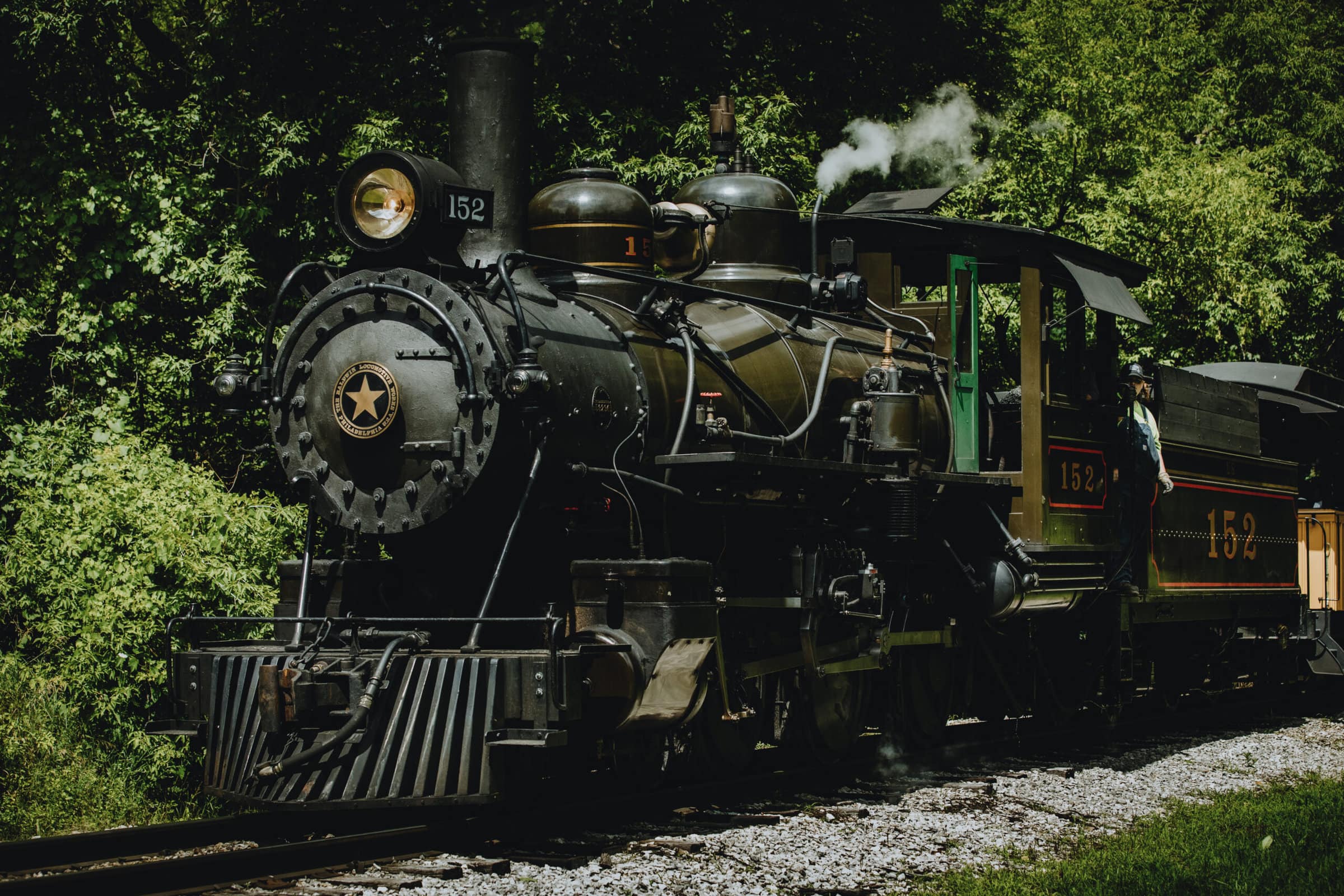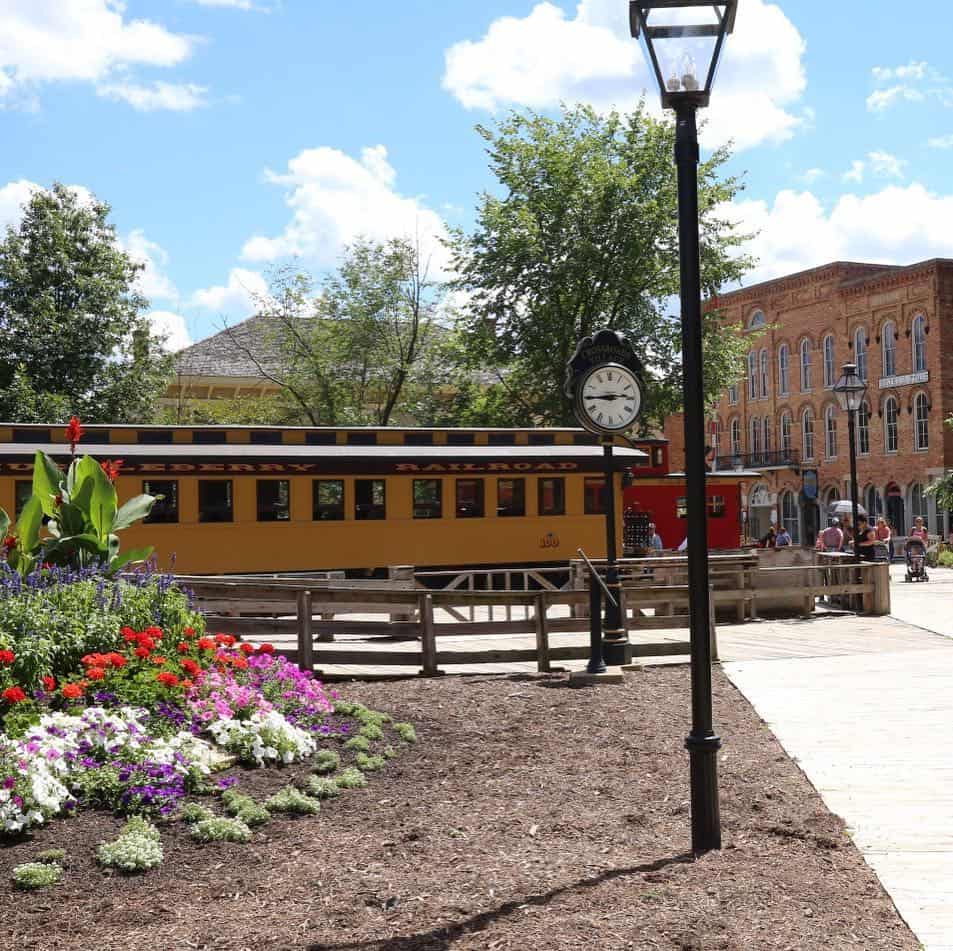Huckleberry Railroad

There is nothing like a train ride on the Huckleberry Railroad to take you back to a simpler time. Enjoy a 40-minute historical journey behind our authentic Baldwin steam locomotive as it takes you along the shores of Mott Lake, down a stretch of the historic Pere Marquette roadbed, and back into the heart of Crossroads Village. Grab the kids or your favorite travel companion and listen for the call of the engineer’s whistle. All aboard the Huckleberry Railroad!
Huckleberry Railroad now features a newly rebuilt diesel Engine #12 that pulls the train on Thursdays and Fridays. Our coal-fired locomotive Engine #152 built by Baldwin Locomotive Works, will pull the train on Saturdays and Sundays. The narrow-gauge railroad’s collection of cars includes eleven original and replica wooden coaches plus, a classic original red wooden caboose.
History Of Huckleberry Railroad Line
The Huckleberry Railroad earned its name from its leisurely pace, allowing passengers to easily hop off, gather huckleberries, and rejoin the train with minimal effort.
Originating in 1857 as part of the Flint Pere Marquette Railroad Company, this railway was a pivotal part of local history. The Flint Pere Marquette Railroad Company, established on June 22, 1857, initially operated the line from Flint to Otter Lake, later known as the Otter Lake Branch, covering 15 miles. Over time, it expanded, stretching an additional 4.5 miles from Otter Lake to Fostoria, culminating in a total track length of 19.5 miles from Flint to Fostoria.
Through various mergers, Pere Marquette became part of the C&O (Chesapeake and Ohio) Railroad, which eventually joined forces with other lines to form the Chessie System. Today, the Chessie System is recognized as CSX, a significant player in the railway industry.
Locomotives (#152 And #464)
Presently, the Huckleberry Railroad runs three locomotives, with #152 and #464 being the primary ones. Currently, #464 is undergoing renovations and is out of service, leaving #152 as the main operational locomotive.
Originally built in June 1920 by the Baldwin Locomotive Works of Philadelphia, #152, formerly known as #2 locomotive, was commissioned by the Alaska Engineering Commission (AEC). It was instrumental in constructing the Alaska Railroad, operating on a three-foot gauge track from Fairbanks to Nenana’s coal mines and Chatanika’s gold rush town. After transitioning ownership from storage at the Alaska Railroad to the U.S. War Department and later being sold to various companies, #152 found its way to the Genesee County Parks and Recreation Commission in 1975. Following extensive restoration, it entered service in 1976 and remains the sole active locomotive since the inception of the Huckleberry Railroad.
However, in January 1990, #152 required significant repairs, leading to its temporary retirement for service. Its replacement, the newly rebuilt #464 locomotive, took over operations. #152 underwent several modifications during this time, including new cab windows, a darker cab stain for realism, and a change from red to black paint for a more traditional appearance. After four years of restoration work, #152 resumed regular service in December 1994.
Preserving historic artifacts like these locomotives requires meticulous care and maintenance. To ensure their longevity, steam locomotives like #152 undergo a thorough inspection and restoration every 1492 days or 15 years of operation. This process involves complete disassembly, meticulous scrutiny of every part, necessary repairs, and final testing, a costly and time-consuming endeavor made possible through the support of the C.S. Mott Foundation. Their generous grant in 2016 facilitated the inspection and restoration of engine #152, ensuring the Huckleberry Railroad’s continued operation for years to come.
The restoration project, initiated in 2016, involved disassembling the engine at Crossroads Village before engaging the Strasburg Railroad in Pennsylvania for the boiler inspection and repair. Thanks to the dedication and expertise of the railroad shop staff, the project was completed ahead of the anticipated five-year timeframe.
The Huckleberry Railroad operates three locomotives, two cabooses, one hopper car, and a motor car (Speeder). Each and every coach, caboose, and car are unique in its origins and history.

Keep Exploring

Huckleberry Railroad

Halloween Ghosts & Goodies

Christmas Holiday Magic

Field Trips

Village Amusement Rides

Summer

Ladies Night Out

Day Out With Thomas

Village Buildings

Railfans Weekend










